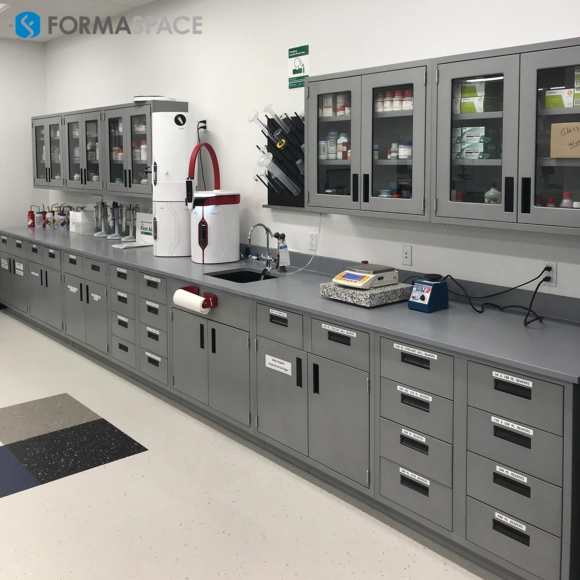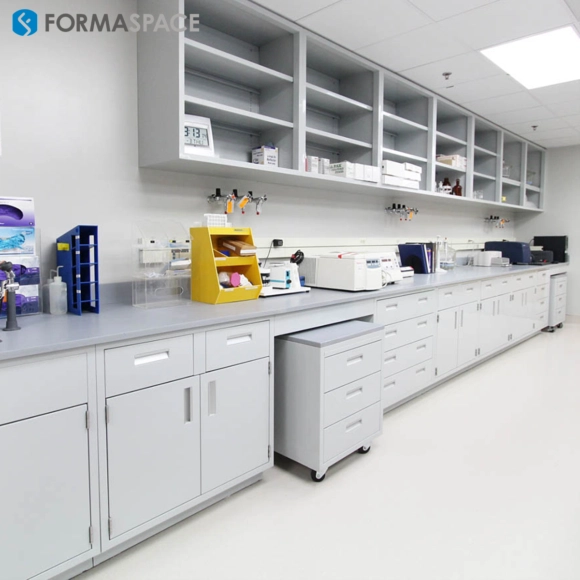With the Biden administration, there is a new sheriff in town when it comes to regulating PFAS chemicals.
We take a look at the different ways Washington could increase regulatory oversight of PFAS chemicals — as well as the new potential business opportunities for water testing laboratories — thanks to proposed increased Federal funding for environmental testing and site cleanup.

PFAS Backgrounder: What Are “Forever Chemicals?”
What does the term PFAS refer to, and how did it get the memorable nickname “forever chemicals?”

PFAS is an acronym for Perfluoroalkyl and Polyfluoroalkyl substances, a large group of man-made synthetic chemical compounds comprised of a chain of carbon and fluorine atoms that first came into widespread use in the late 1940s.
PFAS chemicals have unique qualities that led to their popularization in many products; for example, they are an exceptionally powerful surfactant; e.g. they are slippery, and they can repel water, oil, and grease stains. These properties were put to use in Teflon coated frying pans, Scotch Gard stain-resistant carpets, and Gore-Tex water repellents sportswear.
PFAS chemicals are also inherently long-lasting, meaning compared to other substances, they do not break down easily and can persist in the environment for many years — because the chemical bond between fluorine and carbon atoms (C-F in chemical notation) is one of the strongest ones found in nature.
While chemical longevity can often be considered a benefit in material science, it’s also a potential health risk. Once PFAS chemicals are ingested into the human body, they do not break down quickly (e.g. depending on the specific compound, the half-life might be four or five years), so repeated exposure can raise the level of these chemicals in our blood over time (making them similar to another troubling industrial chemical, Polychlorinated Biphenyls, commonly known as PCBs.)
As a result, PFAS compounds have become commonly known as “forever chemicals,” which not only refers to their inability to break down easily but also refers to their characteristic carbon-fluorine (C-F) chemical bond (albeit reversed as “FC”).
New Discoveries of PFAS Chemicals in Common Consumer Cosmetics Goods
As we mentioned earlier, PFAS is an umbrella term for Perfluoroalkyl and Polyfluoroalkyl substances, a category of more than 4,700 different chemical compounds.
PFAS chemicals fall into three main categories:
- PFOA or C8 – PFOA is perfluorooctanoic acid, a surfactant with a long 8-carbon chain (C8) structure.
- PFOS – PFOS is perfluoro octane sulfonate, a highly stable fluorinated aliphatic compound, also with a long 8-carbon chain (C8) structure.
- GenX – GenX is ammonium salt of hexafluoropropylene oxide dimer acid (HFPO-DA) fluoride, a synthetic short-chain organofluorine chemical compound designed by DuPont as a replacement for PFOA / C8.
As we’ll touch on shortly, the industry has been moving away from the long carbon chain chemicals in favor of newer, short-chain chemicals (such as GenX) to develop alternative chemicals that could (theoretically) break down more rapidly in the environment, hopefully making them safer.
However, PFAS chemicals have been in the news again recently, as researchers at the University of Notre Dame found high levels of fluorine (a test indicator proxy for PFAS chemicals) among 230 commonly used cosmetic products, including 56% of eye and foundation products, 48% of lipstick products, and 47% of mascara products.

PFAS Environmental Hot Spots and Exposure Health Risks
Consumer watchdogs, such as the Environmental Working Group, have been pointing out the potential health dangers of PFAS chemicals for years.
But the news that PFAS chemicals have been detected in cosmetics (in addition to non-stick cookware, waterproof clothing, carpets, fast-food containers, and human blood) has pushed the issue back in the headlines, and, as we’ll see in a moment, onto the top of the legislative agenda.
Concerns about PFAS compounds have been mounting for years. Researchers first noted that certain professions were associated with higher levels of PFAS chemicals in the blood, including industrial workers at PFAS manufacturing plants, firefighters wearing PFAS treated gear or deploying flame retardant, DoD personnel, and even workers who treat skis with wax coatings.
Certain areas of the country are also thought to be environmental hots spots, such as parts of the Ohio River valley, where these chemicals were produced and waste was discharged into waters – where it can now be detected in groundwater. The film Dark Waters highlighted the health risks associated with PFAS polluted waters in this region, now estimated to affect more than 6 million Americans.
Military installations are also thought to be at risk, including nine bases located in the Chesapeake Bay watershed.
So too are areas where oil and gas developers have used fracking chemicals to extract hydrocarbons from underground — which also affects those living in the surrounding areas who could potentially draw well water that’s been contaminated with drilling fluids.
The American Cancer Society reports that workers and those living near PFOA-related chemical plants have a higher risk of testicular cancer. They note there are also possible links to kidney, thyroid, prostate, bladder, and ovarian cancer.
More recently, the famous environmental activist Erin Brockovich has written about how humanity’s long-term survival depends on taking action to limit PFAS compounds, as it’s thought to be a contributing factor in lower human sperm counts, which plummeted 59% between 2011 and 1973. According to the sperm count study author Shanna Swan, an environmental and reproductive epidemiologist at Icahn School of Medicine at Mount Sinai in New York, sperm counts could reach zero by 2045, signally the end of the human race.
Current Legislative and Executive Action on PFAS by the Biden Administration
What is the Biden administration doing about PFAS chemicals?
Following a pledge made during the 2020 presidential campaign, the Biden administration has set forth a plan to significantly increase funding for PFAS toxicity studies as well as designate PFAS as a “hazardous substance,” which could trigger national cleanup measures at hazardous sites, such as DoD military installations and surrounding communities.
The proposed FY 2022 budget sent to Congress back in April 2021 allocates $75 million to speed up PFAS toxicity studies — a figure which should be of great interest to water quality testing laboratories, particularly since the previous administration only proposed spending $6 million and did not push for the “hazardous substance” designation.

The EPA Currently Classifies PFAS as “Compounds of Emerging Concern”
So how has the EPA been responding to the PFAS situation?
Little concrete action took place during the previous administration; the EPA stood by its classification of PFAS chemicals as “Compounds of Emerging Concern” which acknowledged that PFAS can be found in:
- Food and Food Packaging
- Commercial Household Products
- Office and Industrial Work Settings
- Drinking-Water
- Living Organisms
However, with the new incoming Biden administration, times are changing at the EPA.
For example, on the very last day of the Trump administration, the EPA announced a new PFAS Action Plan, which signals that the agency intends to issue new regulations to address PFAS pollution in our waterways (including drinking water) as well as PFAS contamination in consumer products.

Can We Expect the EPA to Implement More Stringent Regulatory Rules on PFAS?
Since the start of the new Biden administration, the EPA has been edging toward greater regulation of PFAS compounds.
For example, In April 2021, the EPA issued its final report on Human Health Toxicity Values for Perfluorobutane Sulfonic Acid (CASRN 375-73-5) and Related Compound Potassium Perfluorobutane Sulfonate (CASRN 29420-49-3).
And in June 2021, the EPA updated its SNUR (Significant Use Rule) for long-chain PFAS compounds to control a loophole on importing PFAS chemical substances.
(This was a major change to the earlier SNUR issued in July 2020 during the Trump administration, which probably would not have been issued at all except that it was required by law as part of the 2016 Frank R. Lautenberg Chemical Safety for the 21st Century Act, commonly known as TSCA (Toxic Substances Control Act).
These changes appear to represent an intermediate step — with further regulations to come.
Analysts think that a future reclassification of PFAS by the EPA as a “hazardous substance” is in the cards, whether it comes at the direction of the White House (as mentioned above), by congressional legislation (discussed below), or as a result of the EPA’s own regulatory determination as part of its new PFAS Action Plan.
This determination will have a big effect on the laboratory testing industry, not least the water testing laboratory segment, as the EPA would have increased powers to oversee the widespread testing, disposal, removal, and environmental mitigation of PFAS pollution.
It also remains to be seen how new regulations issued by the EPA will affect rules issued by the Food and Drug Administration (FDA), which has permitted the use of PFAS since the 1960s for use in food contact applications, including non-stick cookware, gaskets, processing aids, and paper goods used in food packaging.
Efforts by the Chemical Industry to Reduce Impact of PFAS
We should also point out that the leaders in the chemical industry have also been working together to reduce PFAS pollution.
In 2006, the EPA brought together leading chemical companies to create the PFOA Stewardship Program.
This group pledged to work together to reduce and ultimately eliminate PFOA and PFOA-related chemicals in their products, as well as precursor chemicals that could break down into PFOA compounds.
The member organizations participating in the PFOA Stewardship Program include:
- Arkema
- Asahi
- BASF Corporation (successor to Ciba)
- Clariant
- Daikin
- 3M/Dyneon
- DuPont
- Solvay Solexis
As a result, PFOA and PFOS products are no longer manufactured in the United States, which is a significant accomplishment.
However, critics point out some major shortcomings to this approach.
The first issue is that while these chemicals are no longer produced in the United States, they are still produced internationally and can be imported into the US as part of widely available consumer products, including textiles, leather apparel, carpets, paper packaging, coatings, plastics, and rubber.
The second concern is that some US chemical manufacturers responded to the challenge of limiting the use of PFOA and PFOA-related chemicals by introducing substitutes with shorter carbon chains that offer similar performance characteristics as long-chain PFAS chemicals.
The idea behind these products (such as GenX, outlined above) is that they should be able to break down more rapidly in the environment due to their shorter carbon chains; however, for many critics, it’s unclear if this happens in practice or whether these new compounds are also a hazard to human health.

Will New PFAS Legislation Proposed in Congress Become Law?
Meanwhile, legislators in Washington DC are prepared to act.
This past June, Senators Susan Collins (R-Maine) and Richard Blumenthal (D-Conn.) introduced the No PFAS in Cosmetics Act, which would ban the addition of PFAS to cosmetics products sold in the US.
And in July, the US House passed the PFAS Action Act of 2021, with wide bipartisan support, with 23 Republican lawmakers joining all but one Democrat to pass the measure.
The proposed law passed by the House would force the EPA to regulate Perfluoroalkyl and Polyfluoroalkyl substances — e.g. PFOA and PFOS — within two years of enactment as well as designate both of these compounds as “hazardous substances” under the Superfund law within one year.
Lawmakers in Sen. Collins’ home state of Maine have gone one step further.
On July 15, 2021, the Maine government passed a law banning the sale of any product (as of January 1, 2020) containing per- and Polyfluoroalkyl substances (PFAS) that was intentionally added to the product (presumably, this excludes naturally occurring compounds).
They are joined by other states, such as Washington State, New York, and Vermont.
Washington State passed the Pollution Prevention for Our Future Act (SB 5135) in 2019, a measure that prioritizes regulating biochemical classes for action, including PFAS, organohalogen flame retardants, phthalates, alkylphenol ethoxylates, and bisphenols, and PCBs.
And Vermont has passed S.20 (Act 36), which bans the use of PFAS chemicals in firefighting foam, food packaging, and ski wax, as well as carpets, rugs, and stain-resistant treatments.
What Water Testing Laboratories Need to Know about PFAS Business Opportunities
It’s important for water testing laboratories, indeed all testing laboratories in general, to keep tabs on the rapidly changing regulatory and legislative environment concerning PFAS chemicals.
In our view, the new proposed budgetary investment (see notes on the proposed Federal FY 2022 budget above) combined with the potential for reclassifying PFAS compounds as “hazardous substances” would create significant new business opportunities for testing and certification labs in the years to come.
The range of opportunities that could arise from these changes could lead to many new laboratory testing business opportunities, including:
- Develop new testing protocols and automated equipment to support upcoming new regulatory requirements
- OEM certification of test equipment for use in the field or in clinical testing applications
- Water system testing services to identify any amounts of PFAS contamination in a water utility department, school system, food and beverage manufacturing (including packaging), or other industrial capacities
- Forensic fingerprinting of PFAS chemicals to identify their origin source
- Laboratory testing for use at DoD government military installations
- Demand for consumer-driven testing of products
- Field testing of fracking sites used in oil and gas upstream production
- Clinical testing of human blood for the presence of PFAS chemicals
- Litigation services support, e.g. provide expert testimony and testing for use in courts
- Supply chain certification to determine if domestic or imported products and raw materials are in compliance
- Industrial manufacturing testing to make sure products and materials are in compliance
- Support for mitigation projects, e.g. to test from the before, during, and after condition (as well as ongoing environmental monitoring) for Superfund cleanup projects

Creating an Efficient Water Testing Laboratory That’s Built with the Future in Mind
Given these potential new business opportunities, testing laboratories, such as water testing labs, should study their measurement and certification methods and possibly make investments now to ensure they can take advantage of these new opportunities.
Perhaps you can invest in specializing in one area, such as testing water samples for PFAS contamination, but address additional related markets, such as certifying industrial water supplies used in manufacturing, or support mitigation projects, such as assessing Superfund cleanup sites or testing groundwater for traces of PFAS compounds left behind by fracking activities.
On the other hand, you might want to pursue a multi-track approach. For example, if you are currently only engaged in water testing, it might make sense to expand your testing capabilities to address growing adjacent markets, such as testing liquid-based food and beverage products, liquid cosmetics, or firefighting foam products, etc.
The technology is also likely to change in the coming years as laboratory test equipment manufacturers incorporate newer, faster, more accurate test protocols.
Expect to see new developments in liquid chromatography as well as other novel new testing approaches, such as those being developed by researchers from the Harvard John A. Paulson School of Engineering and Applied Sciences (SEAS), which can identify unknown proprietary PFAS compounds or PFAS precursors.
This unprecedented combination of new opportunities — as well as new technologies — creates a unique challenge for laboratory managers who are tasked with updating existing laboratory facilities or in charge of specifying new laboratory designs.
However, the same “future-proofing” principles used in other laboratory applications apply here as well, e.g. the choice of flexible, space-saving modular furniture designs always wins out in the end.
Modular and mobile lab designs, such as those specified at the Chan Zuckerberg BioHub lab, allow lab managers maximum flexibility in re-arranging lab equipment and workbenches for lab personnel as your needs change or when it’s time to incorporate new equipment and protocols into your testing laboratory certification workflow.
Formaspace is Your Partner for Future Proof Laboratory Designs
If you can imagine it, we can build it, here at our factory headquarters in Austin, Texas.
We have built furniture systems for hundreds of laboratories nationwide.
Our client list includes Abbot Laboratories, Amgen, Baxter, Bayer, GlaxoSmithKline, Johnson & Johnson, Merck & Co., Novartis, Pfizer, Roche, and Quest Diagnostics Inc.
Will your project be next? We hope so. Contact your Formaspace Design Consultant today.










